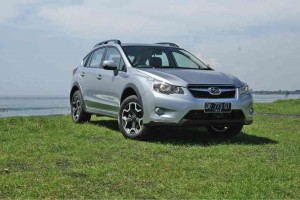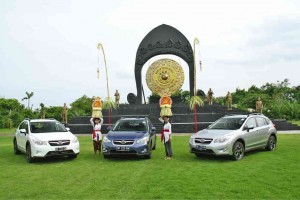Motor Image Enterprises Singapore recently invited select members of the motoring media to test-drive in the beautiful island of Bali, Indonesia, the final production versions of the Subaru XV, currently Motor Image’s hottest-selling compact crossover vehicle in the Asean region.
The experience wasn’t really new to some, who had test-driven the preproduction versions of the best-selling compact crossover utility vehicle late last year at its unveiling at the Jakarta Motorshow 2012 in Indonesia.
But Motor Image Group chief executive Glenn Tan felt there was a need to fully validate the Malaysian-made Subaru XVs’ built quality against the Japanese-made XVs. So they allowed members of the media to drive the XV on harsh terrain: through the open roads of the island of Bali, with its intense heat and humidity, broken tarmac, long and steep uphill climbs through the mountainous inland regions of Bali and through the tight, traffic-riddled areas frequented by tourists.
While the Philippine market enjoys Japanese-made and -supplied Subaru XVs thanks to being one of the few lefthand drive markets in Southeast Asia, the rest of our Asean neighbors, which are righthand drive markets, have the honor of receiving Malaysian-made XVs, made in the recently refurbished (to the tune of $10 million) Tan-Chong Group-owned production facility in Malaysia, of which Motor Image Enterprises is part of.
Initially, the production target was 5,000 XV units annually, but due to strong demand and the lower price brought about by Asean Free Trade Agreement, Motor Image Enterprises has decided to increase sales targets to 7,200-7,500 units annually, an important factor to secure the Singapore-based firm’s log-term stability and foothold on its market share in the entire region. The enterprise hopes to achieve peak production capacity of 10,000 units in five years, but given the huge success of the Malaysian-made XV has enjoyed in the region, it looks like it could hit that target much sooner.
Test-drive at tourist spots
The test-drive, held for over two days, saw the group of 20 Subaru XVs drive through famous tourist spots such as the Elephant Safari Park in the Banjarangkan District, Klungkung District, just over an hour away from the world-famous beach-walks of Bali. Here, the media were treated to an intense drive up: very narrow mountain roads with a variety of surfaces and broken tarmac.
The XV’s suspension and body rigidity were put to the test, as well as the power from the FA20 2.0-liter horizontally opposed boxer engine, which had an output of 150 ps and 195 Newton-meters of torque, and attached to Subaru’s proprietary Lineartronic CVT and Symmetrical All-Wheel Drive System. Leaving it in CVT on uphill stretches provides better power and acceleration for the XV rather than slotting it into manual mode, which was a surprise.
MOTOR Image Enterprises Singapore Group chief executive Glenn Tan (right) and Motor Image Pilipinas general manager Mike Luyun
Another notable destination was the World Peace Gong, built to commemorate the terrible tragedy that befell visitors, most of whom are Australians, over a decade ago when terrorists bombed a famous tourist destination at the beach walk. The intense drive going to the World Peace Gong was soothed away by the cool air conditioning and the Kenwood double DIN multimedia system, one of the only major difference with the Japan-made units we get locally, guiding us to our destination.
Day Two brought us to the Padang Padang Beach, famous for its five- to eight-foot waves. Surfing season is typically from May to September for this beach, which faces the vast Indian Ocean; it gets very dangerously crowded during its peak. But it was off-season when we went so there were but a few surfers undergoing beginner classes, which gave us the chance to romp about the beach and enjoy the benefits of the traction afforded by the Symmetrical All-Wheel Drive system.
At par with counterpart
Through harsh terrain, intense heat and humidity and low and high-speed passes, the Malaysian-made XV proved to be almost indistinguishable from its Japanese-made counterpart. For Tan, this is a sure sign that the Malaysian venture was highly successful for both Fuji Heavy Industries, Subaru’s parent company, and Motor Image Enterprises Singapore.
Tan had very promising news and expectations for the Philippine market, which he shared to us in when we had an interview: With the all-new Subaru Forester—to be launched at the 2013 Manila International Autoshow this April 4 to 7 at the World Trade Center in Pasay City—Motor Image expects to shift roughly 2,000 units of the larger, higher-performing cross-over SUV for fiscal year 2013. Expected price will be at P1.868 million for the top-model turbocharged Forester XT and P1.398 million for the non-turbo Forester 2.0i.
This slots perfectly in between the new-for-2013 prices for the smaller XV: at P1.298 million for the base model 2.0i, P100,000 off compared to the previous one though it loses the panoramic glass moonroof. The premium 2.0 XV’s price remains the same, but it gains a full-leather interior. Luyun attributes the better-priced units to favorable currency exchange rates with the US dollar and Japanese yen versus the Philippine peso.
Motor Image Pilipinas expects a total vehicle sale of 3,000 units for all their model lineup, which includes the XV, Forester, Impreza sedan, STI sedan and hatchback lines, Legacy executive sedan and estate, Outback cross-over and Tribeca SUV. This represents a whopping 92-percent increase in sales from 2012, where Motor Image Subaru only sold 1,800 units.
With six dealerships now fully operational in Greenhills, Fort Bonifacio Global City in Taguig, Westgate in Alabang, Muntinlupa plus two provincial dealerships in Davao City and Cebu City, Motor Image hopes that the increased sales and servicing outlets will help push sales and bring the Subaru brand to the mainstream Filipino mindset and top-of-mind recall. Aside from the six existing dealerships, three more will be opening this year, according to Luyun. These dealerships will be in Cagayan de Oro, Batangas and a Motor Image Manila Bay dealership, with a forth one, a Santa Rosa, Laguna satellite sales office under discussion already.



